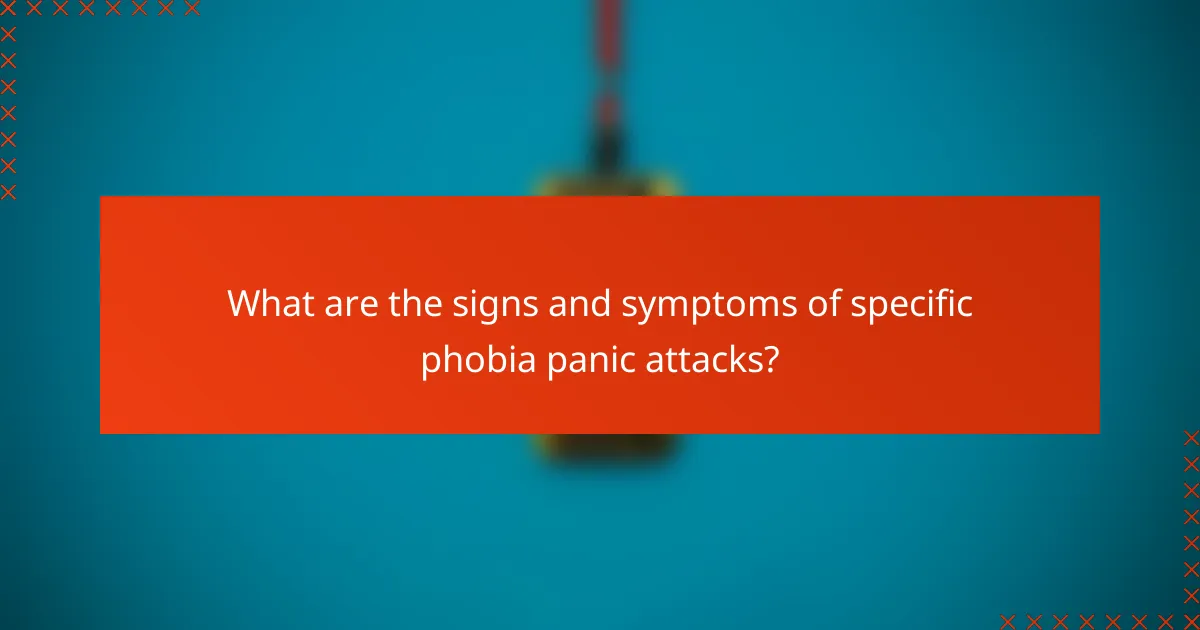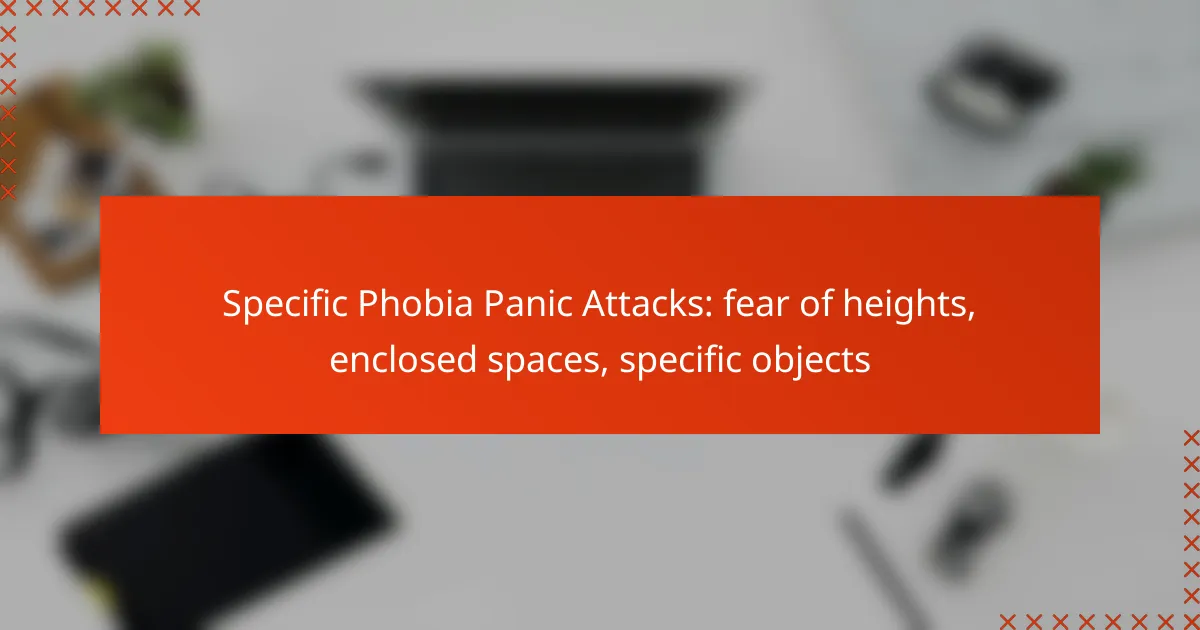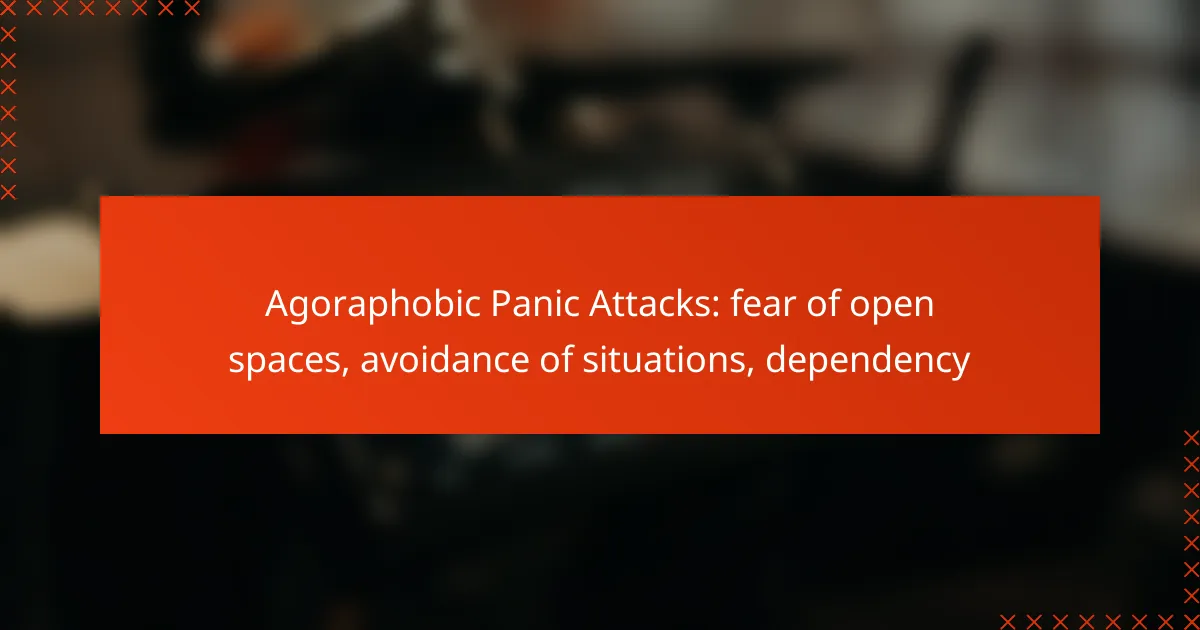Specific phobia panic attacks are intense episodes of fear triggered by particular situations or objects, such as heights, enclosed spaces, or specific items. These episodes can lead to a range of physical, emotional, and cognitive symptoms that significantly disrupt daily life. Understanding and managing these fears through targeted strategies and treatment options is essential for regaining control and reducing anxiety.

What are the treatment options for specific phobia panic attacks in the UK?
Treatment options for specific phobia panic attacks in the UK include various therapeutic approaches, medications, and self-help strategies. These methods aim to reduce anxiety and improve coping mechanisms for individuals facing fears of heights, enclosed spaces, or specific objects.
Cognitive Behavioral Therapy (CBT)
Cognitive Behavioral Therapy (CBT) is a widely used treatment for specific phobias. It focuses on identifying and changing negative thought patterns and behaviors associated with the phobia. Through structured sessions, individuals learn to challenge their fears and develop healthier coping strategies.
Exposure Therapy
Exposure therapy is a key component of treating specific phobias. This technique gradually exposes individuals to the source of their fear in a controlled environment, helping them to confront and reduce their anxiety over time. The exposure can start with less intimidating scenarios and gradually progress to more challenging situations.
In the UK, exposure therapy is often integrated with CBT for more effective results. Patients may work with a therapist to develop a personalized exposure plan, which can significantly lessen the intensity of panic attacks related to their specific phobia.
Medication options
Medication can be a helpful adjunct to therapy for managing specific phobia panic attacks. Common options include selective serotonin reuptake inhibitors (SSRIs) and benzodiazepines, which can help reduce anxiety symptoms. However, medication is typically recommended for short-term use or in conjunction with therapy.
Consulting with a healthcare professional is essential to determine the most appropriate medication and dosage. In the UK, prescriptions are available through the NHS or private healthcare providers, and monitoring is crucial to avoid dependency.
Self-help strategies
Self-help strategies can complement formal treatments for specific phobias. Techniques such as mindfulness, relaxation exercises, and deep breathing can help manage anxiety symptoms during panic attacks. Journaling about fears and progress can also provide insight and motivation.
Engaging in regular physical activity and maintaining a healthy lifestyle can further support mental well-being. Resources like books, apps, and online courses are available in the UK to assist individuals in implementing these self-help techniques effectively.
Support groups
Support groups offer individuals with specific phobias a platform to share experiences and coping strategies. These groups can provide emotional support and reduce feelings of isolation. Many organizations in the UK, such as Anxiety UK, facilitate support groups for those dealing with anxiety and phobias.
Joining a support group can enhance motivation and accountability in managing phobias. Participants often find comfort in knowing they are not alone in their struggles, which can be a powerful aspect of recovery.

How can you manage panic attacks in specific situations?
Managing panic attacks in specific situations involves using targeted techniques tailored to the type of fear, such as heights, enclosed spaces, or specific objects. These strategies can help reduce anxiety and regain control during distressing moments.
Techniques for heights
To manage panic attacks related to heights, gradual exposure is key. Start by visualizing heights in a safe environment, then progress to standing on a low step or balcony. This method, known as desensitization, helps your body acclimate to the fear.
Breathing exercises can also be effective. Practice deep, slow breaths to calm your nervous system when you feel anxious. Focus on inhaling for a count of four, holding for four, and exhaling for four to help reduce panic symptoms.
Techniques for enclosed spaces
For fears of enclosed spaces, begin by practicing relaxation techniques in smaller, confined areas. Sit in a closet or a small room for a few minutes while focusing on your breathing. This can help you feel more comfortable over time.
Using visualization techniques can also aid in managing anxiety. Picture yourself in a safe, open space while in an enclosed area to create a mental escape. Combine this with grounding techniques, such as focusing on physical sensations, to stay present and calm.
Techniques for specific objects
When dealing with specific objects that trigger panic, identify the object and understand your fear. Gradually expose yourself to the object in a controlled manner, starting with images or videos before moving to the real thing.
Incorporating cognitive-behavioral strategies can help reframe your thoughts about the object. Challenge negative beliefs by asking yourself about the likelihood of harm and replacing those thoughts with positive affirmations. This shift can significantly reduce anxiety over time.

What are the signs and symptoms of specific phobia panic attacks?
Specific phobia panic attacks are intense episodes of fear triggered by specific situations or objects, such as heights, enclosed spaces, or particular items. Common signs include physical, emotional, and cognitive symptoms that can significantly impact daily life.
Physical symptoms
During a panic attack related to a specific phobia, individuals may experience a range of physical symptoms. These can include rapid heartbeat, shortness of breath, sweating, trembling, and dizziness. Such reactions are often the body’s fight-or-flight response to perceived danger.
Other physical manifestations might involve nausea, chest pain, or a feeling of choking. These symptoms can be alarming and may lead to avoidance of situations that trigger the phobia, further reinforcing the fear.
Emotional symptoms
Emotional symptoms of specific phobia panic attacks often include feelings of intense fear or dread. Individuals may feel a sense of impending doom or a fear of losing control during an attack. This emotional turmoil can lead to heightened anxiety in anticipation of encountering the feared object or situation.
Additionally, feelings of embarrassment or shame may arise, especially if the panic attack occurs in public. This can result in social withdrawal and avoidance behaviors, which can exacerbate the phobia over time.
Cognitive symptoms
Cognitive symptoms during a panic attack often involve distorted thinking patterns. Individuals may have irrational thoughts about the danger posed by the specific object or situation, leading to catastrophic predictions about what might happen. This can create a cycle of fear that is difficult to break.
Common cognitive responses include difficulty concentrating, a sense of unreality, or feeling detached from oneself. These thoughts can further fuel anxiety and make it challenging to engage in rational decision-making during or after an attack.

What causes specific phobias?
Specific phobias are often caused by a combination of genetic, environmental, and traumatic factors. Understanding these causes can help in addressing and managing the fears associated with heights, enclosed spaces, or specific objects.
Genetic factors
Genetic predisposition plays a significant role in the development of specific phobias. Individuals with a family history of anxiety disorders may be more likely to experience phobias themselves. Research suggests that certain genes may influence how a person responds to fear and stress.
For example, if a parent has a specific phobia, their child may inherit a heightened sensitivity to fear-inducing stimuli. This genetic link can make it easier for phobias to develop, especially in stressful situations.
Environmental influences
Environmental factors, such as upbringing and cultural context, significantly impact the development of specific phobias. Children who grow up in environments where fear is emphasized may learn to associate certain objects or situations with danger.
For instance, if a child frequently hears negative stories about heights or enclosed spaces, they may internalize these fears. Additionally, cultural attitudes towards certain fears can shape how individuals perceive and react to specific phobias.
Traumatic experiences
Traumatic experiences are a common trigger for specific phobias. An individual who has had a frightening encounter with heights, such as falling from a significant height, may develop an intense fear of heights afterward.
These experiences can create lasting associations between the trauma and the feared object or situation. It is crucial to address these past traumas in therapy to help individuals overcome their phobias effectively.

How do specific phobias differ from general anxiety disorders?
Specific phobias are intense, irrational fears of particular objects or situations, while general anxiety disorders involve broader, more pervasive anxiety. Individuals with specific phobias typically experience panic attacks when confronted with their fear, whereas those with general anxiety may feel chronic worry without a specific trigger.
Fear of Heights
Fear of heights, known as acrophobia, is a common specific phobia where individuals experience extreme anxiety when at elevated locations. This fear can lead to panic attacks characterized by symptoms such as rapid heartbeat, sweating, and dizziness. People may avoid situations like climbing stairs, using elevators, or even looking out of tall buildings.
To manage acrophobia, gradual exposure therapy can be effective. This involves slowly confronting the fear in a controlled manner, starting with less intimidating heights and gradually progressing to more challenging situations. Techniques such as deep breathing and visualization can also help reduce anxiety during exposure.
Enclosed Spaces
Enclosed spaces can trigger claustrophobia, a specific phobia where individuals feel intense fear in small or confined areas. Symptoms may include shortness of breath, feelings of suffocation, and panic attacks. Common situations that may provoke this fear include being in elevators, crowded rooms, or even wearing tight clothing.
Addressing claustrophobia often involves cognitive-behavioral therapy (CBT), which helps individuals reframe their thoughts about confined spaces. Practicing relaxation techniques and gradually exposing oneself to smaller spaces can also aid in reducing fear responses.
Specific Objects
Specific objects, such as spiders (arachnophobia) or snakes (ophidiophobia), can evoke strong fear responses in those with specific phobias. The anxiety experienced can lead to avoidance behaviors, impacting daily life and activities. Individuals may go to great lengths to avoid encountering these objects, which can reinforce their fears.
Overcoming fears of specific objects often involves exposure therapy, where individuals are gradually introduced to the feared object in a safe environment. Education about the object and its behavior can also help demystify the fear, making it easier to manage. Support groups can provide additional encouragement and coping strategies.



